How Much Does It Cost To Create an Online Course?
 Platform Review
Platform Review

Learn the true costs of creating an online course, including hardware costs, software costs, and web hosting. Choose between the most affordable option and a slightly more expensive option, learn what free options you have available.
If you're thinking about creating an online course, you're probably curious about the cost.
I wish I had read something like this post when I started as an online course creator - I’d have saved myself a ton of time and money. 😏
I've been creating online courses myself since 2016, and I will tell you everything you need to know about course creation expenses so that you know exactly what you are getting into.
Throughout this post, you’ll learn the true costs of creating an online course, and we will split the total cost into multiple categories.
I’ll share with you the essential equipment, software, and other associated costs that you need to know about, and at the end I'll give you two specific answers:
- The most affordable option for creating an online course
- A slightly more expensive option
For each category, if it's at all possible I will provide you with a free option as well.
Besides breaking down each cost category, I’ll share examples and recommendations based on what I’ve used myself over the years, including a few secret hacks to help you stand out. 😉
So how much does it cost to create an online course?
Creating an online course can range from $200 to $10,000, with labor being the main expense, followed by equipment and software costs. If you're doing it yourself, expenses are minimal—just a good microphone and free software can suffice.
Opting for a full studio, professional editing, or hiring someone else can increase costs to several thousand dollars. However, some of the best courses are often created with minimal equipment by the course creators themselves.
So without further ado, let's explain in more detail, the answer to the question; how much does it cost to create an online course? 🚀
The True Cost of Creating an Online Course
When it comes to building an online course, there are a few essentials to consider:
- Hardware: the physical equipment you need to produce a valuable course
- Software: the software that goes along with this equipment
- Hosting: the place where you put your course material (videos, lessons, etc…)
- Marketing: the tools you use to promote and “sell” your course
We’ll cover each of these, diving into the core tools you need, and many of these I also use personally.
But before we get lost in the details, let's keep one thing in mind: my biggest piece of advice is:
Don't purchase anything upfront before you actually need it. 😉
If you purchase things up front, you risk ending up with a ton of equipment that you rarely use, if at all.
So without further ado, here are the cost categories, and some options for each.
Hardware Costs
I’ve created a separate guide that dives into the essential equipment you need to build an online course (click here to open the Complete Guide to Online Course Equipment).
What I’ll share here is the essential hardware you need to produce a high-quality course without spending more money than you have to.
This begins with arguably the most important purchase you’ll make…
1: Microphone
If there’s one piece of equipment you NEED to get right it’s your microphone.
Audio quality matters. It doesn’t matter who your audience is or what type of course you build… audio quality matters, and a lot!
In fact, your audio quality is much more of a deal-breaker than your video quality.
Most people are usually more than OK with a video that is of a lower resolution than what it could be, but almost no one is OK with broken and unintelligible audio, full of background noise.
That isn’t to say you should spend hundreds of dollars on a microphone, but it does mean you should not rely on your laptop’s mic or headphones that come with your phone.
The microphone I’ve used over the years (and recommended to all creators) is the HD iRig Mic that you can get for a little under $100.
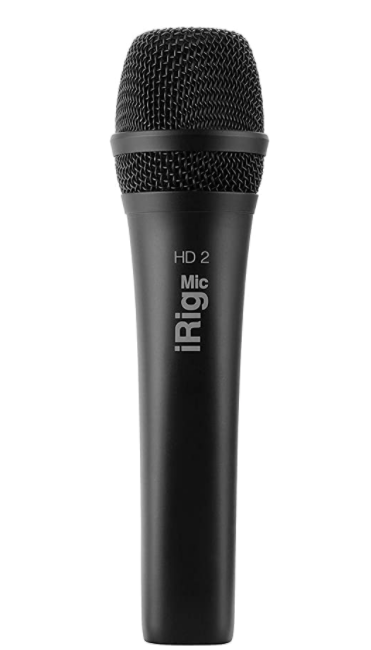
Here is a non-sponsored link to this equipment (all the links in this post are not sponsored, I have no commercial affiliation with these brands or Amazon):
The iRig Mic HD 2 Microphone that I use to record my coursesAs I say, I’ve personally used this mic to create my own courses over the years and have never had any issues.
It’s compatible with iPhone, iPad, Mac, and PC, making it versatile… and is simply a simple mic that produces a great end result. 👍
Now it’s important to note that your microphone isn’t the only thing to consider for your audio.
It is the most important piece, but you also need to take into account:
- Your location (ie: the room and what its acoustics are)
- Mic stand (to ensure it’s located away from your computer/fan noise)
- Pop Filter (to prevent distortion caused by certain sounds)
- Connection (connecting your mic to your laptop/computer)
I go into all this and more in the equipment guide that accompanies this one.
As I mention in it, audio as a whole can be a dangerous rabbit hole you find yourself in.
It’s easy to spend a lot of money on things you don’t need.
Keep it simple. Simply invest in a decent mic and you automatically set yourself apart from the competition, but don't overspend here, it's not worth it.
2: Camera
The next big investment you need to consider is video.
How important this is will depend on the type of course you create and how often you’re in front of the camera.
For example, if you’re a yoga teacher that “shows” your audience how to do certain moves, you’ll need to invest more than if you teach SEO and most of your lessons are done via a slide deck.
Regardless, there will be times you need to appear in front of the camera, and depending on what your laptop’s built-in camera is like, you might need something that goes above and beyond.
In general though, if you have a fairly modern computer, your built-in camera will work just fine. 😉
So again, don't overspend here, but if you really need to then I want to give you a recommendation: The Logitech 1080p Pro Stream Webcam.
You can often get this for under $70, and for the money, you get a lot of value. It’s easy to connect and provides a high-quality HD visual great for recording, live streaming, and even performing one-on-one coaching.

Again, depending on your laptop/computer, your in-built camera may be good enough.
If it is, great. If not, investing in an HD camera like The Logitech 1080p is worth it.
As with audio, your camera only tells part of the story - there are other considerations like Lighting (more of this soon) and building a Green Screen Studio.
3: Lighting
Too often people get so caught up in the type of camera to use they forget about the importance of lighting.
The last thing you want to do is waste your budget on a high-spec camera and then set up your studio in a poorly lit room.
It doesn’t matter how good your camera is, poor lighting ruins everything.
In fact, I'll go as far as saying that the choice of your lighting set up is actually more important than your choice of camera, because usually just about any modern built-in or external camera will do, but without the right lighting, no camera will work well.
In general, there are a few essential lights you need:
- Key Light: this is the main light that focuses on you (or the main subject)
- Fill Light: these lights “fill” in any gaps to remove unwanted shadows
- Backlight: these are used to separate the main subject from the background
How many lights you need and where to place them depends on where you shoot your video.
Where possible, I always recommend people utilize natural light and record in a well-lit room. Yet this isn’t always possible, so it’s worth investing in some solid lighting like this Softbox Studio…

Or some Desk Lights like these…
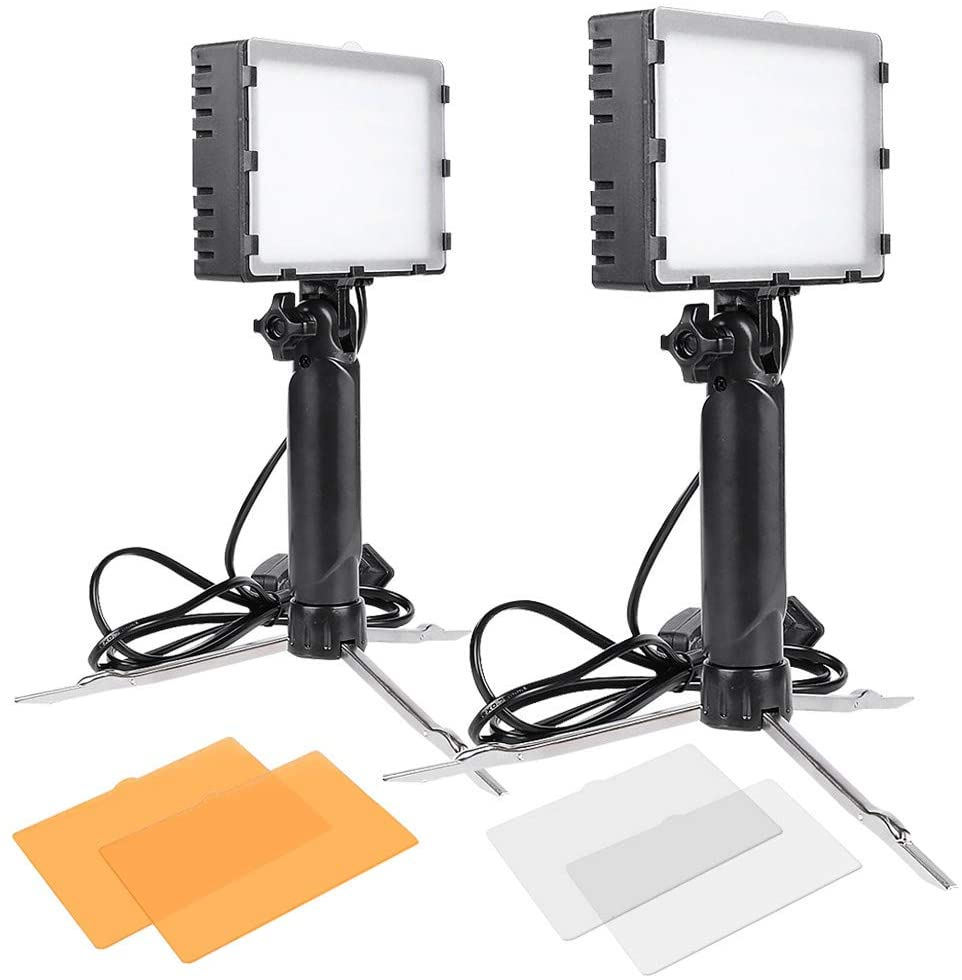
Having a few softbox lights helps you remove any unnecessary shadows and fill your background, whereas the desktop lamps ensure you’re personally well lit (or whatever your main subject is).
For most course creators, spending as little as $60 to 100 on lighting is enough.
But this does depend on where you record your video and the role it plays in your course material.
Don’t waste $500+ on one and then film in a dark studio - your camera can only achieve so much.
4: Headphones
The final piece of essential hardware you need is a set of headphones, although once again this is an item far too many course creators get carried away with.
You DO NOT need a pair of $200 Beats by Dre! 😉
The role of your headphones is simple: to help you hear clearly the sound while you are video editing.
That’s it. In most cases, the headphones that arrive with your phone are more than enough.
So long as it connects with your computer, you’re good to go.
But in practice, the only thing to consider here is comfort…
You’ll likely record a lot of course material over time, so you don’t want a pair of headphones that hurt, and also it's really annoying to have to deal with wires all over your desk all the time.
So I personally recommend something like these JLab Studio Wireless Headphones that go over your ears (instead of in them) and connects via Bluetooth (having hands-free, wireless headphones isn’t essential, but it can make life easier as you move around your desk) - and only costs $20!

Comfort while recording is key and just makes everything easier.
And with the headphones, in terms of the essential hardware you need, that’s it.
A good microphone, a solid camera, decent lighting, and a comfortable pair of headphones ensures a high-quality course your students will love.
In total, you can get all this for under $300!
But remember, most of this material is optional, the only key cost that is not really possible to avoid is the microphone.
Let's now move on to the next cost category: software costs.
Software Costs
Getting the right equipment is important, but it’s also important to remember you’re a course creator that runs much of your business online.
As such, the software you use to create, optimize, promote, and sell your courses matters a lot.
But as with hardware, this can quickly become overwhelming.
And it’s easy to get carried away and buy a bunch of online tools you don’t need.
Based on my experience, these are the essentials:
1: Screen Recording
As a course creator, you will need to record what’s on your screen.
Whether this is to share your slide deck/presentation, virtual tutorials, or explainer videos, I don’t know a single course creator that doesn’t record their screen at least some of the time.
(and for most, like me, it’s an essential part of the process).
The good news is, there are many options to choose from, and most of them are easy to use.
Although many have long lists of features and differ ever so slightly, most of them do the same thing.
As such, don’t get caught up in this. So long as the software you use captures your screen, you have everything you need.
Personally, I bought Screenflow when I started recording videos, and I keep using it to this day and it works great.
Screenflow is a full-blown video editor and video recorder, and I use it every week to tweak my desktop videos that I get from my video editor almost ready to be published.
So I record the raw footage with Screenflow, send the files to him and he sends me back a nearly finished video, that I only have to tweak slightly here and there, review, and publish.
But Screenflow costs around $150 at the time I wrote this post 👀, so I'm also going to give you some other alternative options, including a free one.
A Free Video Editor
A free video editor that was recommended to me by one of our creators (thank you Luxmi 😉) is Free Cam:
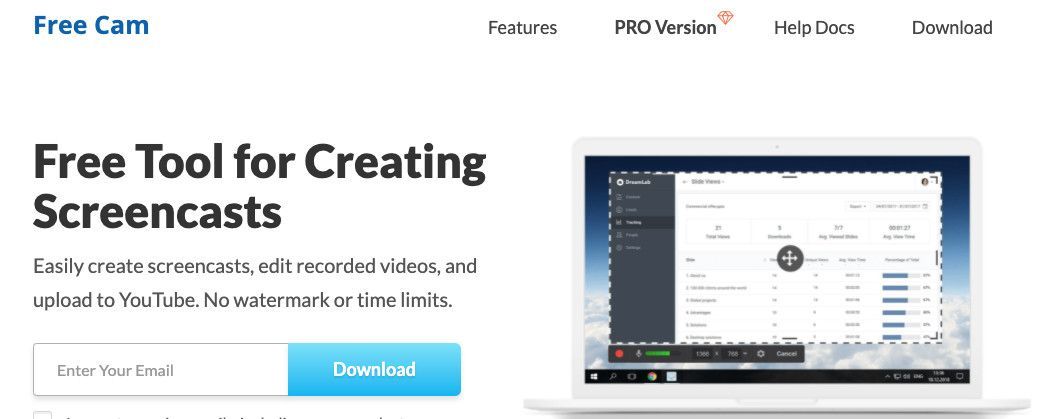
The free version does come with some limitations, but there are no watermarks or time limits, and you will be able to extract 720p videos, so you can record and edit your whole course using it. 😉
One of the limitations of the free version is that you can't extract 1080p videos, but this is not a deal-breaker as 720p still looks great.
Do I really need video editing software?
Most course creators do need some sort of video editor, but because maybe you just want some software to record the videos, and decide to outsource completely the video editing, in that case you wouldn't need a video editor.
You might simply just record the raw footage for free in your Mac using QuickTime, and send the raw video to your editor, which then sends you back the finished product.
In that case, another option that you might consider just for recording your videos is actually Loom, as it not only records your screen but also your face (via your in-built camera or connected webcam).
This is a nice additional feature as it saves you from need any other software when you need to record yourself, plus Loom also brings you some decent video editing features that might just be enough for your needs.
And the best part is that Loom is FREE (or just $8 per month if you need greater access/bandwidth).

3: Slide / Presentation Design
Another important aspect a course creator like yourself needs to consider is your Slide Deck.
Your presentations very likely play a fundamental role in your courses.
You don’t need to create complex presentations, but you do need to produce clear, professional, and attractive slides that stand out - you want to keep your student’s attention throughout 😎
This is something else you may like to outsource, and once again Fiverr is a great place to look.
Whereas if this is something you’d like to do yourself, look no further than Google Slides or Canva.
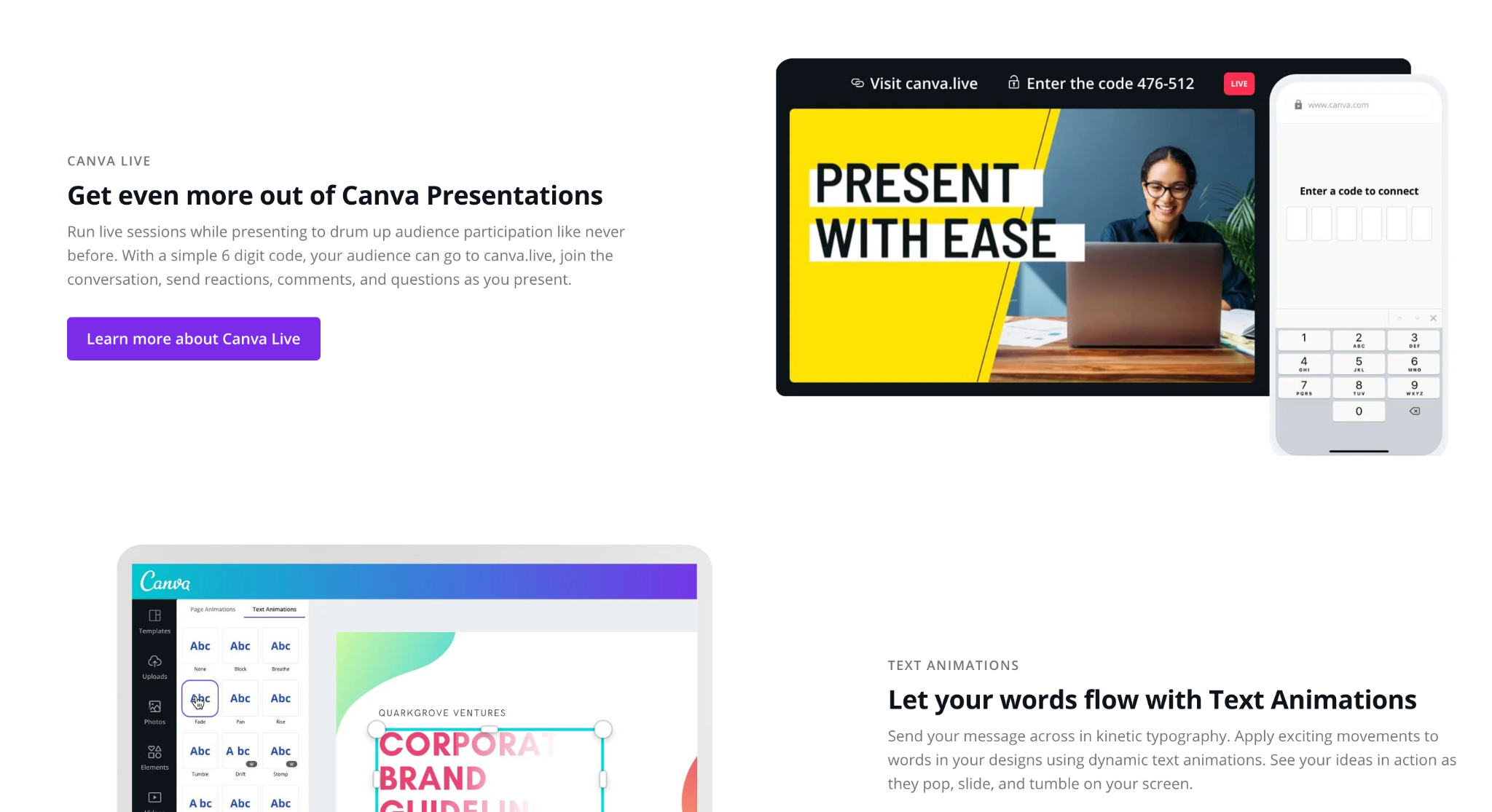
Both are free, easy to use, and give you access to everything you need to design great slides.
There’s no need to complicate things or waste money on expensive design software.
In fact, you can outsource the initial design of a template to someone on Fiverr and then use this over and over as you create new presentations.
4: Stock Images / Video
This is something you may or may not need to consider because if you outsource your design work, your designer will do this for you. Whereas if you design and build your own presentations, there are times you need to add images, graphics, tables, and even videos.
Doing so can be a minefield as the last thing you want to do is share something you’re not allowed to.
As such, I suggest you head to Unsplash for all your image/video needs…

Getting access to these images is free, although you’ll have to reference many of them.
Let's now talk about another important cost associated with online courses: web hosting.
Web Hosting Costs
One of the biggest decisions you have to make as a course creator is how to host your courses.
There are three approaches:
- Self-Hosting
- Marketplaces
- All-in-One Platform
There’s no right or wrong approach. It comes down to you, your situation, and your goals.
But if you want to:
- focus as much as possible on course production and less on tech
- develop your own brand and business instead of being a partner of a third-party business
Then an all-in-one platform is the way to go! 😎 🚀
Let's quickly cover the different options available:
1: Self-Hosted
Your first option is self-hosted, which certainly offers the greatest freedom.
The downsides to this though is cost, time and the need for extra skills.
Not just the financial cost, but the overall time, resources, and energy it requires.
Basically, when you self-host your courses you have to sort everything:
- Website design and development
- Website maintenance and security
- Domain hosting
- Video hosting
- Learning management system (LMS)
- SEO
- Payment processing
- to name just a few…
The costs quickly add up, and you are the person responsible for all this, including server upgrades.
You’ll almost certainly have to outsource a lot of this to others (again, costly), unless you have the technical skills to do it yourself (again, time-consuming).
And honestly… the stress this brings often outweighs any positives.
Yet this is the right approach for some course creators.
If that’s you, you’ll likely want to build your new online home using WordPress and then utilize at least some of the following options:
- Hosting: Domain.com ($20-30 per year)
- Video Hosting: Wistia ($99 per month)
- Payment Processing: PayPal (2-3% per transaction)
In time, you’ll need to consider other plugins, tools, and software to keep your website secure, as well as continuous maintenance costs (that you’ll likely have to outsource to developers and designers).
If you’re still new to online courses and building your brand, this is not the route I suggest.
Actually, even if you are not new to online courses, this is still not the best route in my opinion.
It might be a good idea 5 years ago to try to create an online course website by gluing together 10 WordPress plugins, but not anymore and I think trying to do so nowadays would put you at a disadvantage.
2: Online Course Marketplace(s)
Another approach you can take is to build and promote your course on marketplaces like Udemy or Skillshare.
If you’ve followed my journey in recent years, you know I’m a huge advocate of marketplaces like Udemy (just read this article I wrote on my Udemy revenue).
It’s a great approach for reaching new students and keeping your costs low, but as I talk about in more detail here… there are downsides to hosting your course on marketplaces.
You have less freedom, for one, both around design and usability, and how what you can charge (as well as having to split your revenue with Udemy, Skillshare, et al).
You can still earn a lot of money this way, but it just has a lower ceiling.
Good for new course creators, but after a while, I think you’ll want to spread your wings.
This brings us to the third and final option 👇 👇 👇
3: All-in-One Platforms
The best solution for course creators that are not super technical, or that don't want to spend so much time taking care of the tech side is to go for an all-in-one online course platform.
An all-in-one course platform gives you everything that you need to publish and sell your online courses on your own website.
They all offer more or less the same base set of features, but none is easier to use or provides a more premium user experience to both students and course creators alike than OnlineCourseHost.com. 👍
With this platform, you can create your online courses for free, no design or technical skills are needed.
You’ll get access to all the features that you need to build a gorgeous online course website and a great-looking course sales page:
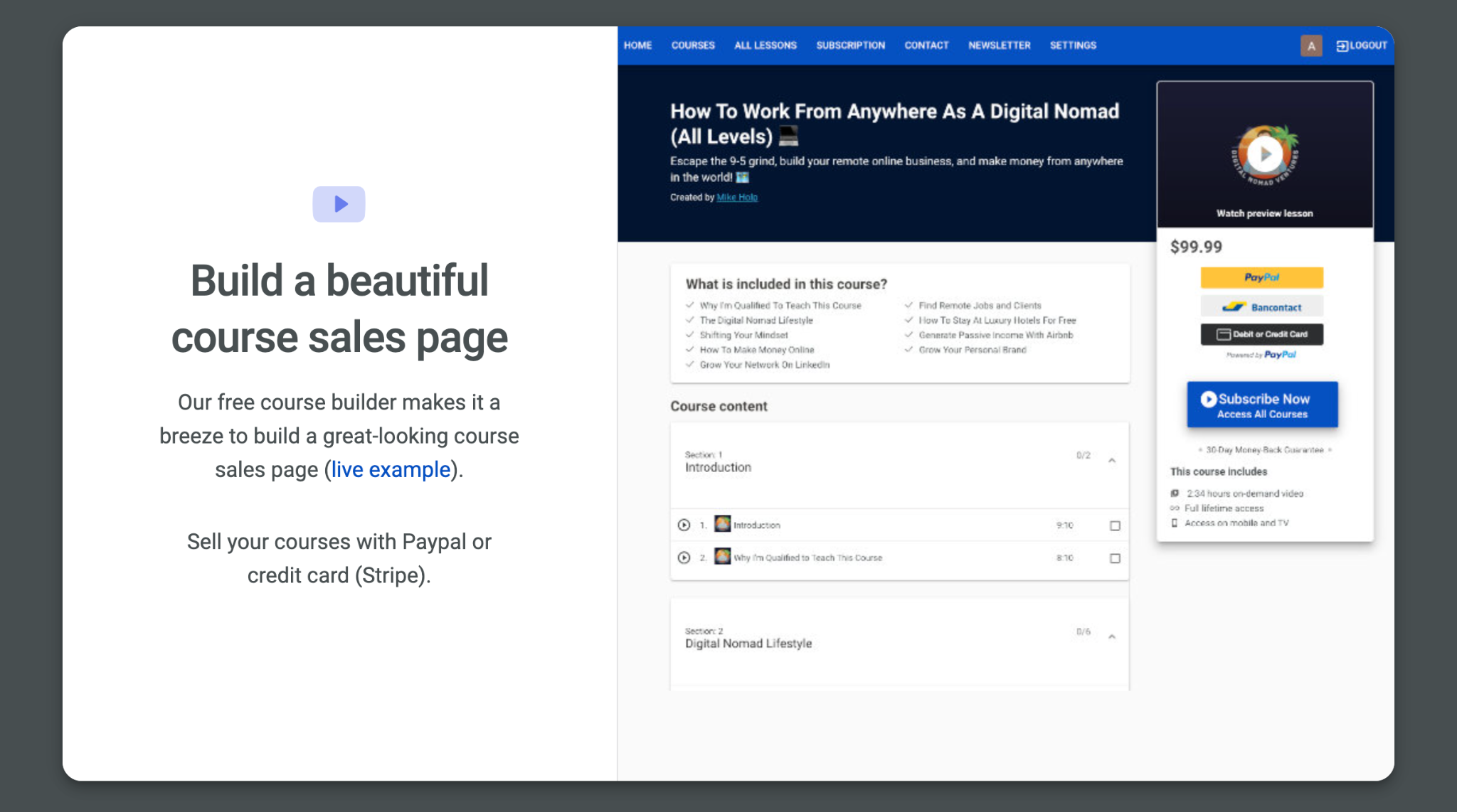
You can create up to 3 courses for free in the Free plan, but other than that you can create and sell courses with Paypal and Stripe to an unlimited number of students using the Free plan.
You can try it out, just sign up and create a free account (no card needed), fill in a form with two fields (choose your subdomain and website name), and that's it. 😉
Create your Free Course Creator Account
You will then have a website up and running in minutes, and you can start creating your courses with this super easy-to-use course editor:
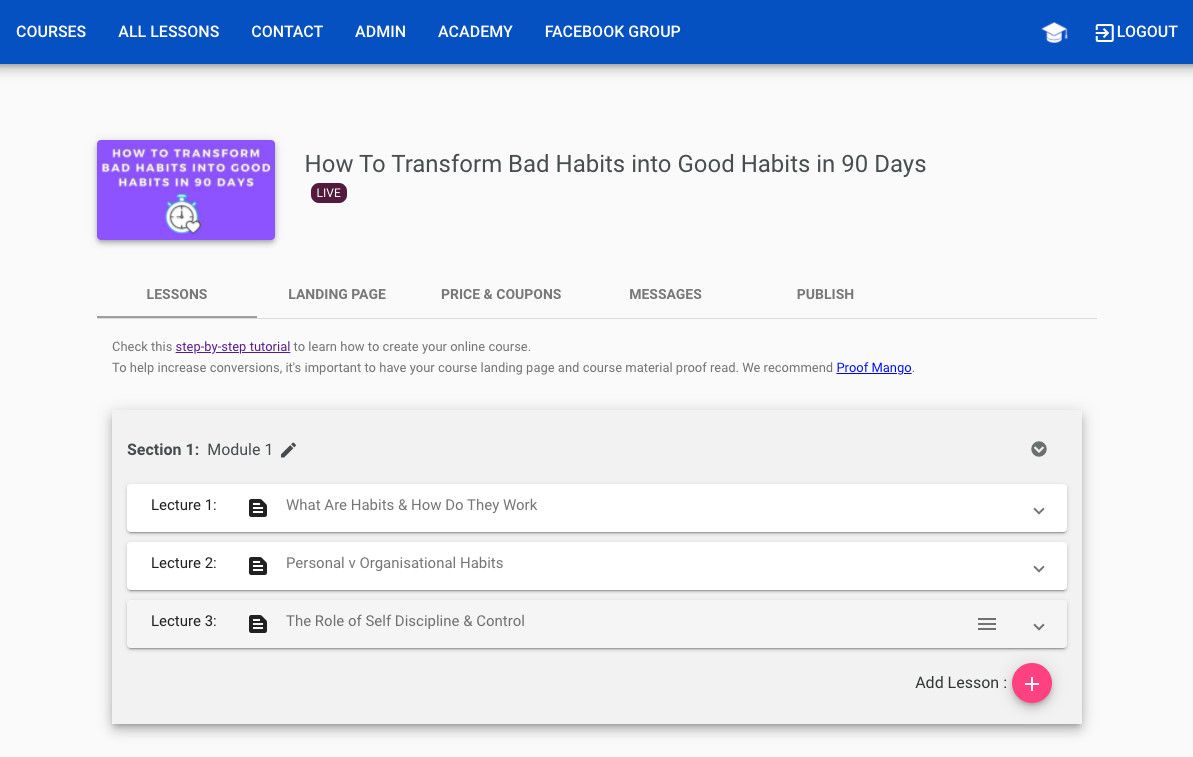
Let's now account for all the costs that we talked about in this post, summarize everything and give a couple of total cost estimates.
How Much Does It Cost To Create an Online Course?
As you now know, there’s a lot that goes into creating your course.
Some tools and resources are essential. Many are not. As with most business ventures, you can spend A LOT of money on things you don’t need.
My main hope with this guide is that you now see how pointless this is. 😉
What matters is building a high-quality course that has an impact on your students.
And in most cases, this doesn’t have to cost a lot of money at all.
So if we sum it all up, here are some of the options you have available:
The Affordable Online Course
Here is how much it costs to create an online course, if going for the most affordable options available, trying to use free products whenever possible:
- Microphone: HD iRig Mic - $99.99
- Camera: InBuilt Camera - Free
- Lighting: Softbox Studio and Desk Lights - $72.50
- Headphones: Ones That Come with Your Phone - Free
- Screen Recording and Editing Software: Free Cam - Free
- Slide Design/Creation: Google Slides and Canva - Free
- Website/Landing Page: OnlineCourseHost.com - Free (up to 3 courses, unlimited students)
- Email Marketing: MailerLite - Free up to 1000 emails
- Graphic Design: Fiverr - $20 - for thumbnail design
TOTAL COST: $192.49
As you can see, for under $200, you can create a very high-quality online course.
There are a few shortcuts you take with this option, including using the free camera built into your laptop, the headphones that come with your phone, and using free video editing, but you’ll likely get by).
And if you want to skip the lighting costs and go for desktop videos only, and try to do your own thumbnail art, then you could create a course just for the price of the microphone - $99.99. 😉
This option takes a minimal approach to what you outsource, too, so you are doing most of the work yourself.
If you have a slightly larger budget and want to create a course that stands out, you may find this next option to your liking 😎👇👇
The Slightly More Expensive Online Course
Even if you want to spend slightly more on software and equipment, you will see that it's still surprisingly affordable to create a high-quality online course:
- Microphone: HD iRig Mic - $99.99
- Camera: The Logitech 1080p Pro Stream Webcam - $60
- Lighting: Softbox Studio and Desk Lights - $72.50
- Headphones: JLab Studio Wireless Headphones - $21.99
- Screen Recording Software: Screenflow - $149
- Slide Design/Creation: Google Slides and Canva - Free
- Website/Landing Page: OnlineCourseHost.com - Free (up to 3 courses, unlimited students)
- Email Marketing: MailerLite - Free (up to 1000 subscribers)
- Graphic Design: Fiverr - $100 (for thumbnails, social media art, cover images, etc.)
TOTAL COST: $503.48
Many people assume it costs thousands of dollars to create an online course.
This simply is not the case. 😉
Even with a slightly more expensive option like the one above, you barely spend around $500.
You just need to know what to spend your money on and how to best spend your time…
Conclusion: How much does it cost to create an online course?
There’s a lot of tools, equipment, software, and other shiny objects you *could* spend your money on.
But the truth is, purchasing the right equipment is the easy part, and it's hard to go wrong with that.
The tough part is finding out how to grow an audience to sell your course to, as well as finding the right course topic, how to promote your course, etc.
This is why we have created the Course Creator Academy so that you can learn all these course creation skills completely for free.
If you want to interact with other course creators, and get answers to all your questions from our course creation experts, then sign up to the Academy:
The Academy is also present on Facebook, so come and join our community:
Join our Course Creator Facebook Group
If you’ve found this guide valuable, you may like to explore other Course Creator Academy Guides:
- Best online course platforms (Ultimate Guide)
- How to research course topics
- How to choose the right equipment
- how to record an online course
- How to create an online course website for free
- How to sell an online course
- How to create an online course business
- How to create a powerful brand around your online course(s)
- How to create a high-converting sales page
- How to create the perfect funnel for your online courses
- and much more
Thanks for reading… and enjoy the course creation process! 😉
Vasco Cavalheiro
OnlineCourseHost.com Founder & Online Course Creator
LinkedIn Facebook Page Facebook Group Twitter
You are welcome to ask me any questions in the comments below: 👇👇👇








 Start Here
Start Here Course Creation Journey Step by Step
Course Creation Journey Step by Step  Course Creation Software Reviews
Course Creation Software Reviews Online Course Marketing
Online Course Marketing Course Creation Tips & Tricks
Course Creation Tips & Tricks Course Equipment
Course Equipment Online Course Marketplaces
Online Course Marketplaces Revenue Reports
Revenue Reports Best Practices
Best Practices Frequently Asked Questions
Frequently Asked Questions Platform Reviews
Platform Reviews